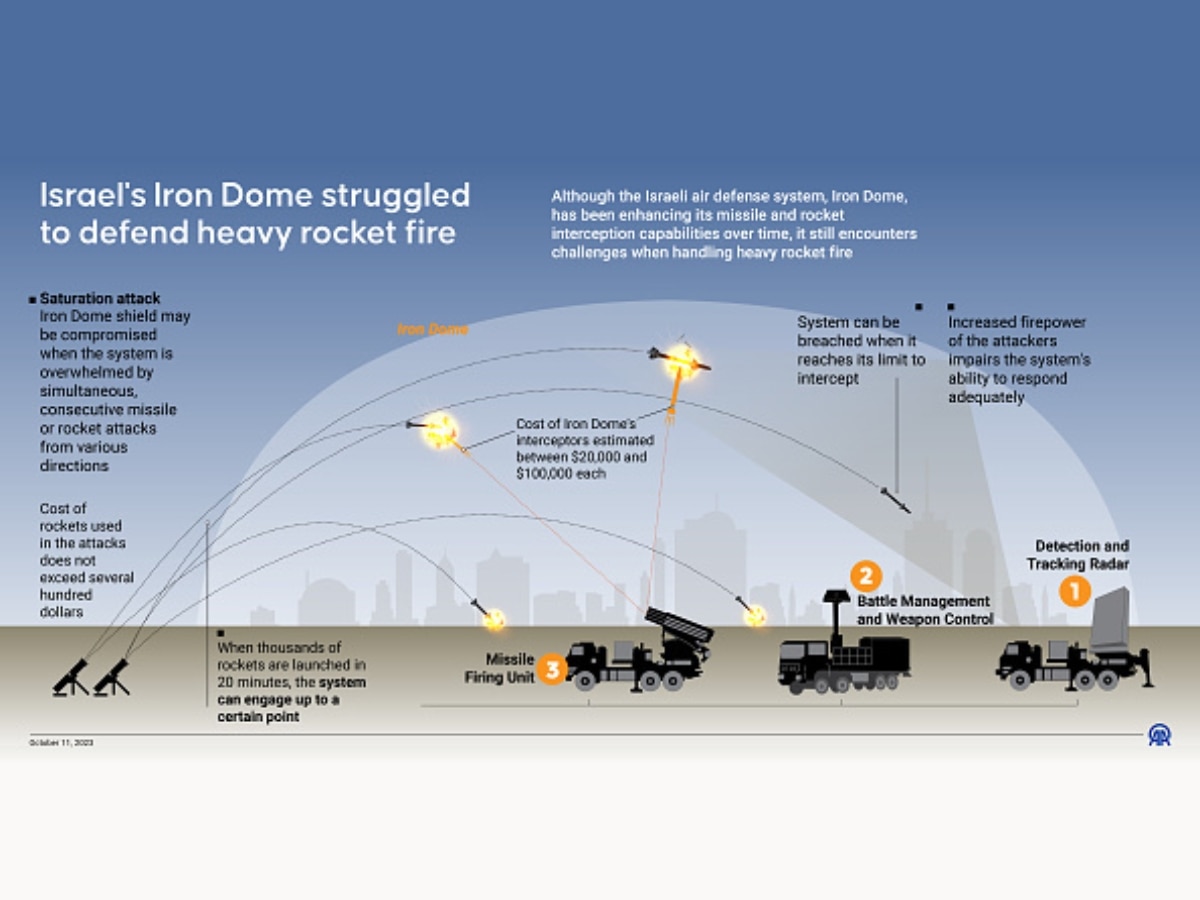There Are Lessons For India To Learn From Israel's Iron Dome Failure In Hamas Attack

While Israel says casualties would have been much higher if there were no Iron Dome, the enemy purpose would be well served if even one nuclear missile is able to penetrate the missile defence layers
The failure of the reputed 'Iron Dome' anti-missile system aimed at protecting Israel has raised many eyebrows in the global strategic circles. Questions are being raised if these anti-missile systems are truly fool proof? Is there any solid guarantee of protection from enemy missile attacks? Is it worth spending billions of dollars on such systems to provide a façade of defence against missile attacks? While Israel says the casualty rate would have been much higher without the 'Iron Dome', if even one nuclear missile is able to penetrate the missile defence layers the purpose of the enemy would be well served.
As the world had been watching with shock and horror how Palestinian militant group Hamas has been showering rockets on some of Israel's heavily protected cities, governments and armies have learnt a lesson that the 'Iron Dome' gets confused when there is a barrage of missile launches. If the enemy is determined to harm the adversary, simultaneous launch of scores of missiles on enemy targets would meet the desired objective. But despite these deficiencies in the system, countries continue to deploy such anti-missile systems.
Commenting on the failure of Iron Dome, American Aerospace engineer Iain Boyd said: “The Hamas attack will have repercussions for all of the world’s major military powers. It clearly illustrates the need for air defence systems that are much more effective in two important ways. First, there is the need for a much deeper arsenal of defensive weapons that can address a very large number of threats. Second, the cost per defensive weapon needs to be reduced significantly.”
Anti-Missile Systems With India

After three decades of its successful ballistic missile development programme, India now possesses short-range 350-km Prithvi to long-range Agni-5 (5,000 km range), which is acting as a major deterrent for the enemies. They know very well that India would not hesitate and immediately retaliate. However, with more and more countries acquiring such long-range ballistic missiles, the need would always be felt to have an assured defensive system to protect the country from getting hit by these high-speed missiles with conventional or nuclear warheads.
To defend from an incoming ballistic or cruise missile exploding on its capital or other big populated city or important strategic locations, developed countries like the US, Russia or Israel deployed their own ballistic missile defence systems a few decades ago. The US has Advanced Patriot, THAAD and AEGIS anti-missile systems deployed on various locations, whereas Russia has developed and deployed its most advanced S-400 anti-missile systems. Israel has not lagged behind, and to protect itself from rockets and missiles thrown by Palestinians or the Iranians, the tiny nation has deployed Iron Dome and ARROW anti-missile systems.
India has its own indigenous missile defence programme initiated since 2000 after the 1999 Kargil war, even as India’s principal adversaries Pakistan and China continue to threaten India with their long-range ballistic missiles. After the end of Kargil war, the then Atal Bihari Vajpayee government launched a major ballistic missile defence system program, which has been tested successfully several times. The first such claim was made by Defence Research and Development Organisation (DRDO) in November 2006, but it has not been made operational yet. As China continues to threaten India with long-range (up to 12,000 km) ballistic missiles, and is also transferring its medium-range ballistic missiles to Pakistan, the threat perception continues to deepen. Hence, India requested Russia to transfer its most advanced S-400 anti-missile systems to India as an interim measure.
The acquisition of five Russian S-400 anti-missile systems at a huge cost of USD 5.25 billion made it obvious that Indian defence planners were not confident of their own developed anti-missile systems — Prithvi Air Defence Missile (PAD) and Advanced Air Defence (AAD) missile. The PAD was designed for high altitude interception whereas the AAD was designed for lower altitude interception. This two-tiered shield is designed to intercept an incoming ballistic missile launched from a range of 5,000 km. The system comprises an overlapping network of early warning and tracking radars, as well as command and control posts. PAD was first tested in November 2006 and AAD a year later. Thus, India became the fourth nation to successfully test such anti-missile systems. However, the county is still far away from actual deployment of these indigenously developed systems to defend its important cities and locations.
To be 'Atmanirbhar' or self-reliant in such very expensive and most advanced missile interceptor systems, the Indian government has recently asked the DRDO to develop Long Range Surface to Air Missile System ( LR-SAM ) under the project Kusha. DRDO officials claim the interceptor missile developed under this system could match the capabilities of the S-400 anti-missiles, three of which have already been acquired and deployed on Northern borders. As reported by the media, the defence ministry has sanctioned five LR-SAM squadrons worth Rs 22,000 crore. These anti-missiles can tackle any aerial target, whether a missile or aircraft, at the maximum range of 350 km.
However, the reality of such anti-missile systems came to light during the ongoing Israel-Hamas war.



No comments:
Post a Comment